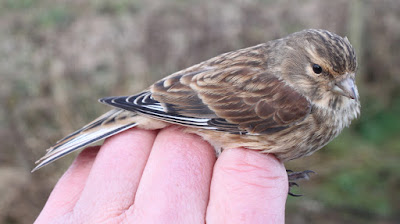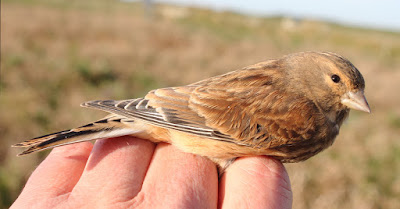The morning started with a double first of the winter – a squirt of de-icer on the windscreen followed by switching on the heated screen and bum warmer. I’m all for gadgets that do away with scrapers and icy fingers, not to mention enjoying the luxury of a cosy backside while birding.
The heater was on full blast as I drove slowly east over Stalmine Moss and towards Cockerham. On the outskirts of Pilling village I watched a Barn Owl hunt over the whitened fields. “Rather it than me” I thought as I watched it glide along the icy gullies and then slowly vanish into the distance of the next farm.
Barn Owl
I stopped at Gulf Lane to check on the Linnet flock and found 200+ comprised of three or more highly mobile groups still finding food in the single field of set-aside. A bird ringer in Scotland contacted me to ask about the composition of the seed mix as he too is interested in a Linnet catching project. Richard the farmer tells me it is a standard wild bird composite from Oliver Seeds but with added wildflower mix. Whatever it is, it certainly works by keeping the Linnets coming back for more and where good numbers of them have found food for the last three months.
Linnet
At Sand Villa and Braides Farm my combined counts gave approximates of 350 Lapwing, 250 Golden Plover and 120 Curlew, but also 8 Whooper Swan, 4 Teal and 1 fence hopping Buzzard.
At Conder Green counts from the pool and the creeks approximated wildfowl to 240 Teal, 130 Mallard, 22 Wigeon and 8 Little Grebe. Otherwise, 3 Little Egret, 18 Redshank, 6 Curlew, 1 Spotted Redshank.
I hoped for a few Goldeneye at Glasson where a frost or two often makes the diving ducks vacate the estuary for the increased temperatures of the yacht basin. But not today, although the numbers of Tufted Duck look to be on the increase with 34, plus a single Great Crested Grebe.
A drive around Moss Lane and Jeremy Lane proved useful when I located a flock of about 250 mainly Fieldfares with but a handful of Redwings. It was exactly a week ago when a drive around the same fields produced much the same result except that I don’t think these were the same birds today, just new arrivals finding the same food source of hawthorn berries.
The Fieldfares proved difficult to pin down to any particular stretch of berries when at one point more than hundred flew en-masse towards the main road and in the direction of Thurnham Hall. That still left a hundred and more in the original spot but where cars speed past to constantly stop the birds’ attempts to feed.
Our winter thrushes are intensely shy, little wonder when on their winter journeys they are subjected to intense hunting should they reach France and Spain. Once again I sat motionless in the car hoping to picture them in the hawthorns. A little success. A few pictures of both birds and berries.
Song Thrush
Fieldfare
Fieldfare
Redwing
Redwing
There are more birds soon by logging in to Another Bird Blog. Don’t forget.
Now go back and “click the pics” for a feast of hawthorn berries.
Linking today to Anni's Blog and Eileen's Saturday.
Linking today to Anni's Blog and Eileen's Saturday.










































.jpeg)












.jpg)












